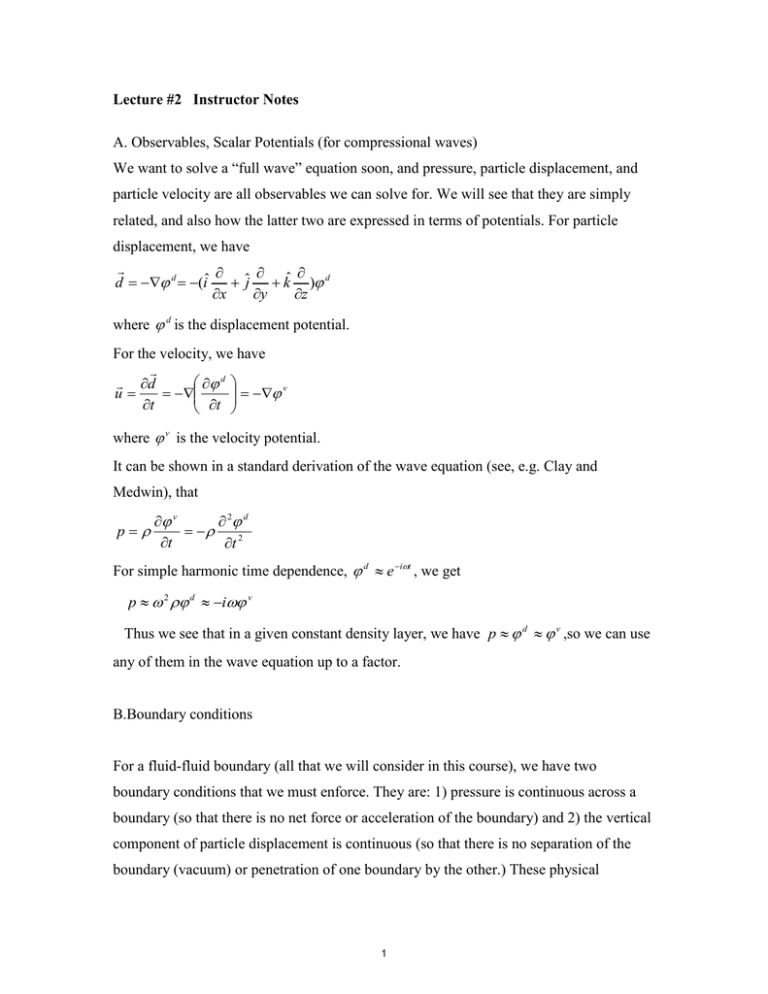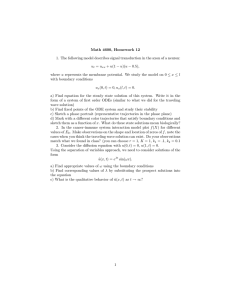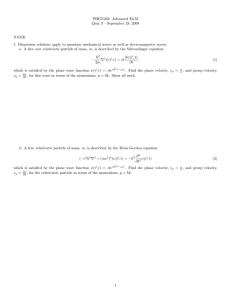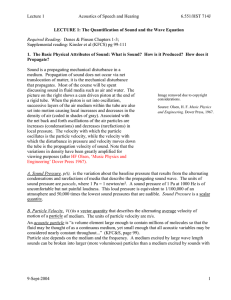Lecture #2 Instructor Notes
advertisement

Lecture #2 Instructor Notes A. Observables, Scalar Potentials (for compressional waves) We want to solve a “full wave” equation soon, and pressure, particle displacement, and particle velocity are all observables we can solve for. We will see that they are simply related, and also how the latter two are expressed in terms of potentials. For particle displacement, we have d d (iˆ ˆj kˆ ) d x y z where d is the displacement potential. For the velocity, we have d d v u t t where v is the velocity potential. It can be shown in a standard derivation of the wave equation (see, e.g. Clay and Medwin), that p v 2 d t t 2 For simple harmonic time dependence, d e it , we get p 2 d i v Thus we see that in a given constant density layer, we have p d v ,so we can use any of them in the wave equation up to a factor. B.Boundary conditions For a fluid-fluid boundary (all that we will consider in this course), we have two boundary conditions that we must enforce. They are: 1) pressure is continuous across a boundary (so that there is no net force or acceleration of the boundary) and 2) the vertical component of particle displacement is continuous (so that there is no separation of the boundary (vacuum) or penetration of one boundary by the other.) These physical 1 constraints lead to boundary conditions for pressure, displacement potential, and velocity potential. Let’s look at these, with medium 0 above and medium 1 below. 1. Pressure p0 p1 from continuity of pressure 1d 0d d 0 perp d1 perp z z Replacing d p / 2 ,we get 1 p0 1 p1 0 z 1 z Thus we have pressure boundary conditions with a 1/ρ factor included. This is an easy factor to forget – please don’t! 2. Displacement potential Again replacing d p / 2 ,we get using continuity of pressure 0 0d 11d And as before 1d 0d z z 3. Velocity potential Using p i v , we use continuity of pressure to get 0 0v 11v And looking at 1d 0d t z t z and switching the order of the t and z derivatives, we get 1v 0v z z Now we have some simple BC’s to work with, going across boundaries! 2 C. Specific acoustic impedance There is always something interesting that one can learn by using analogies to electrical and mechanical circuits. Here, we take a look at what Ohm’s Law can tell us about acoustics. If we take velocity |⃗ ⃗ | current I and pressure p voltage E, then we can use Ohm’s law E=IR to define the acoustic resistance R (or in the more general case of complex quantities, the acoustic impedance Z) to define the acoustic impedance as ⃗ ⃗ ⃗ If we now consider an acoustic plane wave with velocity potential ⃗⃗⃗⃗ ⃗ and use and ⃗⃗ ⃗ we get ⃗ ⃗ ⃗ ⃗⃗ ⃗⃗ For the pressure and velocity in phase, the impedance is real, and is equal to the familiar (to acousticians!) “rho-c” . If one considers spherical waves, then one gets complex impedances, which are not very much more difficult to deal with. In the farfield, the spherical wave impedance becomes the plane wave impedance seen above. 3 MIT OpenCourseWare http://ocw.mit.edu 2.682 Acoustical Oceanography Spring 2012 For information about citing these materials or our Terms of Use, visit: http://ocw.mit.edu/terms.





